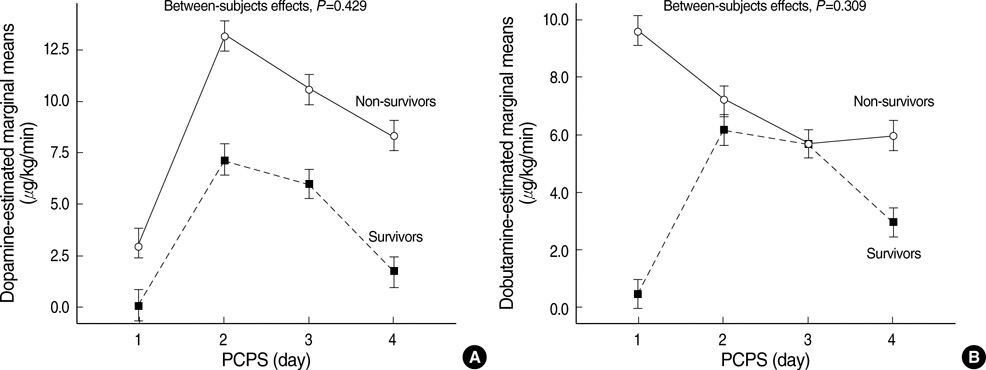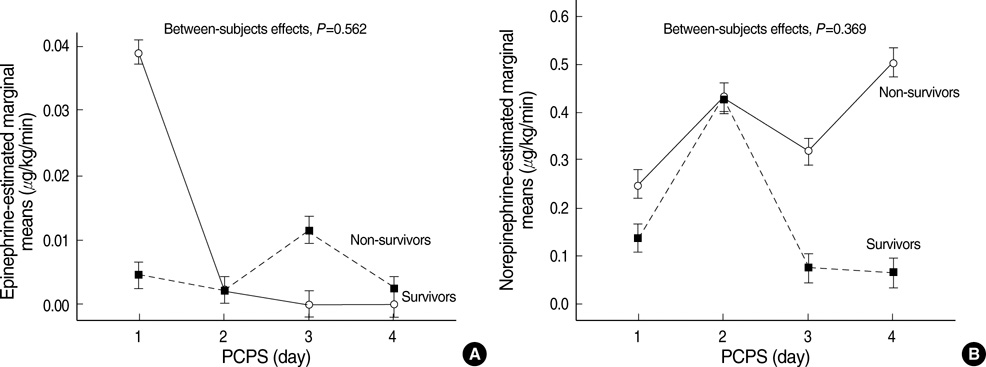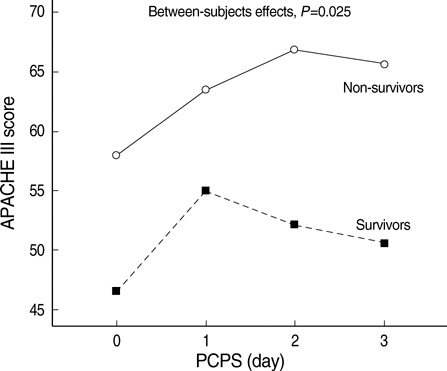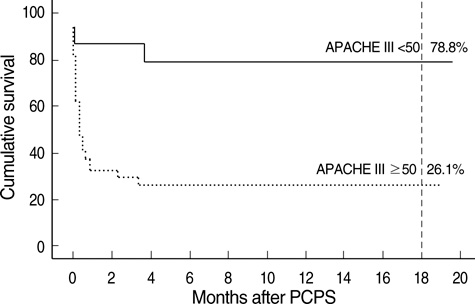J Korean Med Sci.
2009 Dec;24(6):1064-1070. 10.3346/jkms.2009.24.6.1064.
Earlier Application of Percutaneous Cardiopulmonary Support Rescues Patients from Severe Cardiopulmonary Failure Using the APACHE III Scoring System
- Affiliations
-
- 1Department of Thoracic and Cardiovascular Surgery, Gangnam Severance Hospital, Yonsei University College of Medicine, Seoul, Korea.
- 2Department of Cardiovascular Surgery, Yonsei Cardiovascular Center, Severance Hospital, Yonsei University College of Medicine, Seoul, Korea. kjy@yuhs.ac
- KMID: 1783134
- DOI: http://doi.org/10.3346/jkms.2009.24.6.1064
Abstract
- Percutaneous cardiopulmonary support (PCPS) is a widely accepted treatment for severe cardiopulmonary failure. This system, which uses a percutaneous approach and autopriming devices, can be rapidly applied in emergency situations. We sought to identify the risk factors that could help predict in-hospital mortality, and to assess its outcomes in survivors. During a 2-yr period, 50 patients underwent PCPS for the treatment of severe cardiopulmonary failure, and of those, 22 (44%) were classified as survivors and 28 (56%) as non-survivors. We compared the 2 groups for risk factors of in-hospital mortality and to establish proper PCPS timing. Twenty patients underwent PCPS for acute myocardial infarction, 20 for severe cardiopulmonary failure after cardiac surgery, 7 for acute respiratory distress syndrome, and 3 for acute myocarditis. Multivariate analysis showed that an acute physiology, age, and chronic health evaluation (APACHE) III score > or =50 prior to PCPS was the only significant predictor of in-hospital mortality (P=0.001). Overall 18-month survival was 42.2%. Cox analysis showed patients with APACHE III scores > or =50 had a poor prognosis (P=0.001). Earlier application of PCPS, and other preemptive strategies designed to optimize high-risk patients, may improve patient outcomes. Identifying patients with high APACHE scores at the beginning of PCPS may predict in-hospital mortality. Survivors, particularly those with higher APACHE scores, may require more frequent follow-up to improve overall survival.
MeSH Terms
Figure
Reference
-
1. Phillips SJ, Ballentine B, Slonine D, Hall J, Vandehaar J, Kongtahworn C, Zeff RH, Skinner JR, Reckmo K, Gray D. Percutaneous initiation of cardiopulmonary bypass. Ann Thorac Surg. 1983. 36:223–225.
Article2. Vogel RA, Shawl F, Tommaso C, O'Neill W, Overlie P, O'Toole J, Vandormael M, Topol E, Tabari KK, Vogel J. Initial report of the National Registry of Elective Cardiopulmonary Bypass Supported Coronary Angioplasty. J Am Coll Cardiol. 1990. 15:23–29.
Article3. Magovern GJ Jr, Magovern JA, Benckart DH, Lazzara RR, Sakert T, Maher TD Jr, Clark RE. Extracorporeal membrane oxygenation: preliminary results in patients with postcardiotomy cardiogenic shock. Ann Thorac Surg. 1994. 57:1462–1468.
Article4. Mair P, Hoermann C, Moertl M, Bonatti J, Falbesoner C, Balogh D. Percutaneous venoarterial extracorporeal membrane oxygenation for emergency mechanical circulatory support. Resuscitation. 1996. 33:29–34.
Article5. Younger JG, Schreiner RJ, Swaniker F, Hirschl RB, Chapman RA, Bartlett RH. Extracorporeal resuscitation of cardiac arrest. Acad Emerg Med. 1999. 6:700–707.
Article6. Hata M, Shiono M, Orime Y, Yagi SY, Yamamoto T, Okumura H, Kimura SI, Nakata KI, Kashiwazaki S, Choh S, Negishi N, Sezai Y. Strategy of circulatory support with percutaneous cardiopulmonary support. Artif Organs. 2000. 24:636–639.7. Knaus WA, Wagner DP, Draper EA, Zimmerman JE, Bergner M, Bastos PG, Sirio CA, Murphy DJ, Lotring T, Damiano A. The APACHE III prognostic system. Risk prediction of hospital mortality for critically ill hospitalized adults. Chest. 1991. 100:1619–1636.8. Kurusz M, Zwischenberger JB. Percutaneous cardiopulmonary bypass for cardiac emergencies. Perfusion. 2002. 17:269–277.
Article9. Hayashi Y, Ohtake S, Sawa Y, Nishimura M, Ichikawa H, Satoh H, Yamaguchi T, Suhara H, Sakaguchi T, Matsuda H. Percutaneous cardiopulmonary support with heparin-coated circuits in postcardiotomy cardiogenic shock. Efficacy and comparison with left heart bypass. Jpn J Thorac Cardiovasc Surg. 2000. 48:274–279.10. Chen YS, Chao A, Yu HY, Ko WJ, Wu IH, Chen RJ, Huang SC, Lin FY, Wang SS. Analysis and results of prolonged resuscitation in cardiac arrest patients rescued by extracorporeal membrane oxygenation. J Am Coll Cardiol. 2003. 41:197–203.
Article11. Aiba T, Nonogi H, Itoh T, Morii I, Daikoku S, Goto Y, Miyazaki S, Sasako Y, Nakatani T. Appropriate indications for the use of a percutaneous cardiopulmonary support system in cases with cardiogenic shock complicating acute myocardial infarction. Jpn Circ J. 2001. 65:145–149.
Article12. Suárez de Lezo J, Pan M, Medina A, Pavlovic D, Romero M, Segura J, Ruiz M, Ojeda S, Muñoz J, Rodriguez M. Percutaneous cardiopulmonary support in critical patients needing coronary interventions with stents. Catheter Cardiovasc Interv. 2002. 57:467–475.
Article13. Mooney MR, Arom KV, Joyce LD, Mooney JF, Goldenberg IF, Von Rueden TJ, Emery RW. Emergency cardiopulmonary bypass support in patients with cardiac arrest. J Thorac Cardiovasc Surg. 1991. 101:450–454.
Article14. Shawl FA, Domanski MJ, Punja S, Hernandez TJ. Percutaneous cardiopulmonary bypass support in high-risk patients undergoing percutaneous transluminal coronary angioplasty. Am J Cardiol. 1989. 64:1258–1263.
Article15. Shawl FA, Domanski MJ, Wish MH, Davis M. Percutaneous cardiopulmonary bypass support in the catheterization laboratory: technique and complications. Am Heart J. 1990. 120:195–203.
Article
- Full Text Links
- Actions
-
Cited
- CITED
-
- Close
- Share
- Similar articles
-
- Respiratory Support by Performing Percutaneous CardiopulmonarySupport (PCPS) for Tracheal Resection and Reconstruction in Patients withSevere Distal Tracheal Stenosis
- Successful use of percutaneous cardiopulmonary support in patients with cardiogenic shock due to myocardial infarction: Report of two cases
- Clinical Utility of APACHE III Scoring System as a Method for Predicting the Patient with Cardiovascular Disease admitted in Coronary Care Unit (CCU)
- Cardiopulmonary Support for High Risk Percutaneous Transluminal Coronary Angioplasty
- Anesthetic Management of Complete Tracheal Transection using Percutaneous Cardiopulmonary Support System : A case report





